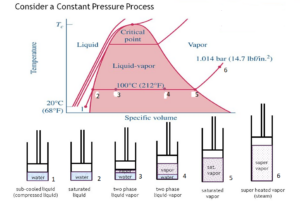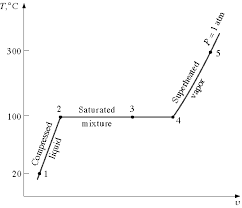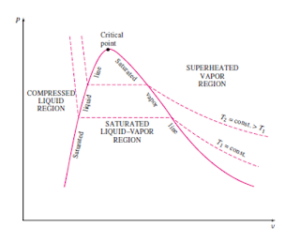Saturated Liquid VS Subcooled Liquid: Need to know Critical Facts
Saturated liquid and subcooled liquid are the different stages during the phase change process of a pure liquid. The principal phases of a pure substance are Solid, Liquid, and Gas.
Subcooled liquid refers to that phase of a substance where it exists in liquid form at a temperature below its boiling point at the system pressure. The saturated liquid is a liquid that is about to vaporize, which means any decrease in pressure without changing its temperature causes it to boil.

Image Credit: Saturated liquid Vs Subcooled liquid https://s3.studentvip.com.au/notes/11438-
Any liquid, whether in its pure form or in a mixture exerts a specific pressure over the surface of the liquid at a particular temperature, which is called the vapor pressure of the substance at that temperature. If the temperature of the liquid increases, its vapor pressure also increases. As this vapor pressure equals the pressure of the surrounding atmosphere, the liquid starts to boil. The liquid at its boiling point is called a saturated liquid.
For example, water is a saturated liquid at its boiling point of 100°C under the atmospheric condition at Sea level or 1-atmosphere pressure. As water is cooled below 100°C, it becomes sub-cooled. As the pressure is increased beyond 1 atmosphere, the boiling point of water increases, or it becomes a sub-cooled liquid at 100 °C.
Subcooled liquid example
Any liquid below its boiling temperature at a given pressure can be considered as a Subcooled liquid.
Water boils at 373 °K(100° C). Now water at room temperature293°K(25°C) andat normal atmospheric pressure is an example of a Subcooled liquid.
Certain conditions that cause a liquid to be Subcooled are:
At a given system pressure when the liquid attains a temperature lower than its saturation temperature. When the liquid is at a pressure higher than its saturation pressure at the given temperature. Thermodynamically the liquid has lower enthalpy and Specific volume than that of a saturated liquid.

Image credit: T-v diagram representing phase change for water at constant pressure https://engineering.purdue.edu/CFDLAB/class/me200/filesFall2010/me200_notes_f10_week3.pdf
Some other examples of sub cooled liquid are:
- Liquid ammonia at a temperature below -33.3°C and pressure 1 bar or higher.
- Liquid ammonia at a temperature below -50°C and pressure 0.41 bar or higher.
- Ethylene glycol at a temperature below 197 C and pressure 1 bar or higher
- Ethyl alcohol at a temperature below 77.8 C and pressure 1 bar or higher.
As can be seen above, in the example of liquid ammonia, it can exit in sub-cooled conditions at different conditions of pressure and temperature. -33.3°C is the saturation temperature of ammonia at 1 bar pressure. Similarly, for a temperature of -50°C, the corresponding saturation pressure for ammonia is 0.41 bar (approx).
Subcooled liquid pressure
A liquid with a pressure higher than its saturation pressure at the given temperature is said to be a Sub-cooled or Compressed liquid.
Sub-cooled liquid means that the temperature of the liquid is lower than the saturation temperature for that particular pressure and a compressed liquid means that the pressure of the liquid is superior than the saturation pressure for the given temperature. Both the terms can be used alternatively.
Since liquids are incompressible in nature, their properties are relatively independent of pressure. Subcooled liquids are defined by:
- Higher pressure than a saturated liquid(P>Psatat a given T)
- Lower temperature than a saturated liquid(T<Tsat at a given P)
- Lower enthalpy than a saturated liquid(h<hfat a given T or P)
- Lower internal energy than a saturated liquid(u<ufat a given T or P)
- Lower specific volume than a saturated liquid (v<vf at a given T or P)
Enthalpy is mostly affected by pressure, a more accurate relationship for h
hf~hf@T+vf(P-Psat)

Image Credit:P-V Diagram of a pure substance http://processandinstrumentation.blogspot.com/
Frequently Asked Questions
Q. What is the difference between Saturated and Subcooled liquid?
Ans:Thoughboth Saturated liquid and Subcooled liquid are the two phases of the same liquid, they are quite different from each other.
Subcooled is the condition where the liquid is colder than the minimum temperature (saturation temperature), which is required to keep it away fromboiling. On the contrary saturated liquid is the condition when the liquid is almost at its boiling point.
In the case of saturated liquid, if the pressure is further lowered andkeeping the temperature constant, the saturatedliquid will start to boil. On the other hand, the liquid will besub-cooled if pressure is increased beyond its saturated pressure at its boiling point.
Q. Why is sub-cooling desirable in a refrigeration system?
Ans:A sub-cooled liquid increases the energy efficiency of a refrigeration system as it has lower specific volume
The refrigerant is sub cooled in the condenser to avoid the early vaporization of the refrigerant before heading towards the expansion device.
If proper condenser surface area is not provided to ensure proper subcooling, the refrigerant may partially evaporate in the piping as it moves to the expansion device. If the refrigerant partially evaporates before entering the expansion device, it will require higher refrigerant volume to be pumped to achieve the same cooling. This increases the pumping cost and hence the energy consumption.

I am Sangeeta Das. I have completed my Masters in Mechanical Engineering with specialization in I.C Engine and Automobiles. I have around ten years of experience encompassing industry and academia. My area of interest includes I.C. Engines, Aerodynamics and Fluid Mechanics. You can reach me at